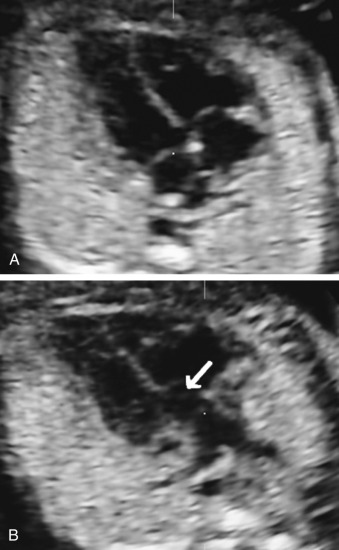Abstract
Common arterial trunk is a rare congenital heart defect characterized by a single great artery connecting both ventricles, responsible for the pulmonary, systemic, and coronary circulation. It is frequently associated to other structural and chromosomal abnormalities. Genomic microarray and targeted ultrasound (US) should be offered. Prognosis depends on the associated abnormalities, the pulmonary and systemic vascular disposition, and the presence of hydrops. Periodical follow-up and tertiary care delivery are recommended.
Keywords
congenital heart defect, conotruncal anomaly, common arterial trunk
Disease
Definition
CAT is characterized by a single great artery connecting both ventricles, which is responsible for the pulmonary, systemic, and coronary circulation ( ).
Prevalence and Epidemiology
CAT accounts for 1% of all congenital heart diseases (CHDs), and it is frequently associated with other anomalies, especially 22q11 microdeletion (30%), and other cardiac (35% and 50%) and extracardiac (35%) anomalies. The most frequently associated CHDs are aortic arch abnormalities and absence of the ductus arteriosus, although tricuspid atresia and double-inlet ventricle have also been described.
Etiology and Pathophysiology
Embryologically, CAT is the consequence of a failure of septation of the truncal artery, whereby the aortopulmonary septum and subpulmonary infundibulum are missing. The truncal valve annulus is usually dysplastic and is formed by two, three, or four cusps. It may be stenotic, incompetent, or both. The common truncal artery supplies the pulmonary, aortic, and coronary circulations. Coronary artery patterns are abnormal in many patients; the most frequent variations are an intramural course and a single coronary artery. Classifications for CAT by Collett and Edwards and R. Van Praagh and S. Van Praagh are shown in Tables 88.1 and 88.2 .
| Type | Anatomic Features |
|---|---|
| I | Main pulmonary trunk originates from common trunk. |
| II | Absence of pulmonary trunk. Pulmonary arteries originate separately but with proximate origins from common trunk. |
| III | Absence of pulmonary trunk. Pulmonary arteries arise laterally from the arterial trunk. |
| IV | Pulmonary branches arise from the aorta (now accepted as pulmonary atresia with VSD). |
| Type | Anatomic Features |
|---|---|
| A1 | Origin of partially separate main pulmonary trunk from common trunk. Corresponds to Collett and Edwards type I. |
| A2 | Pulmonary arteries originate separately from common trunk. |
| A3 | Absence of one pulmonary artery. The other originates from the ductus arteriosus or directly from the descending aorta (hemitruncus). |
| A4 | Defined by coexistence of interrupted aortic arch or aortic hypoplasia. |
Manifestations of Disease
Clinical Presentation
Although CAT can be asymptomatic in utero, the truncal valve is frequently dysplastic and can be associated with moderate to severe valve regurgitation. The latter may lead to cardiac failure and hydrops. Postnatal manifestations appear during the first days of life and are a consequence of saturated and desaturated blood flow mixing and a nonrestrictive left-to-right shunt, resulting in a variable degree of cyanosis and pulmonary vascular disease.
Imaging Technique and Findings
Ultrasound
- •
The four-chamber view on ultrasound (US) is typically normal, unless other anomalies are associated. Levocardia is a common finding ( Fig. 88.1A ).











